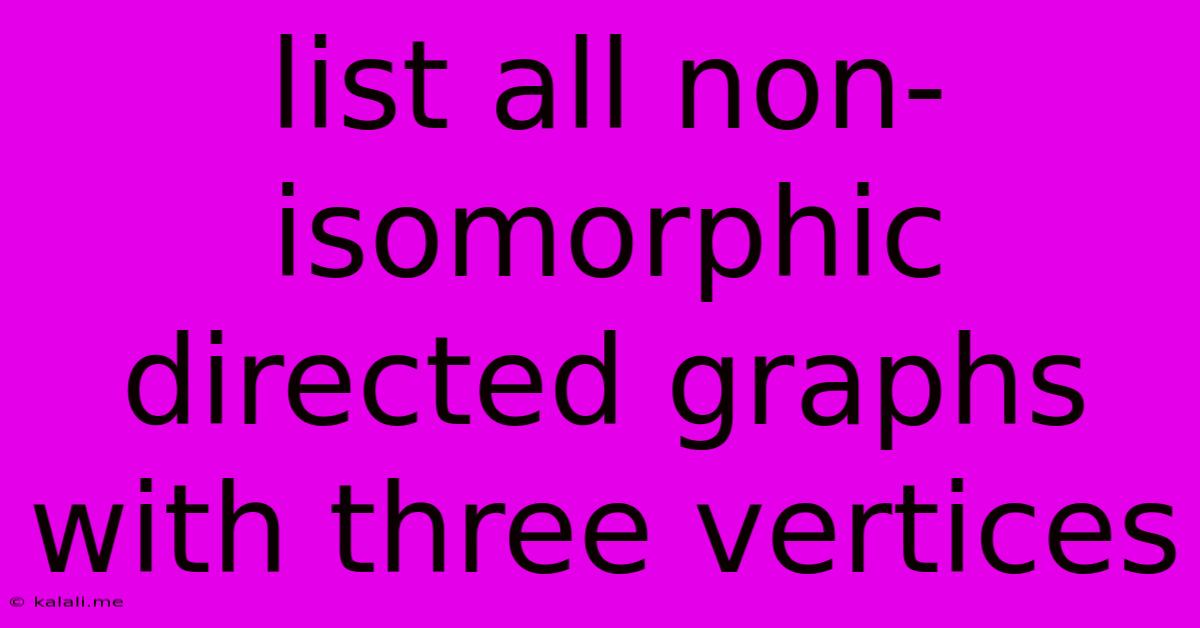List All Non-isomorphic Directed Graphs With Three Vertices
Kalali
Jun 09, 2025 · 3 min read

Table of Contents
All Non-Isomorphic Directed Graphs with Three Vertices
This article comprehensively lists all non-isomorphic directed graphs with three vertices. Understanding directed graphs, also known as digraphs, is crucial in various fields like computer science, network analysis, and social sciences. A directed graph consists of vertices (nodes) and directed edges (arcs) that indicate a relationship between vertices with a specific direction. Two directed graphs are isomorphic if there's a one-to-one correspondence between their vertices such that the directed edges are preserved. This means we are looking for graphs that are structurally different. We'll explore how to systematically identify and categorize these graphs.
Understanding Isomorphism in Directed Graphs
Before listing the graphs, it's vital to understand the concept of isomorphism. Two directed graphs are considered isomorphic if you can relabel the vertices of one graph to exactly match the structure of the other, including the direction of the edges. Simply rearranging the vertices visually isn't enough; the connections and directions must be identical after the relabeling.
Systematic Approach to Finding Non-Isomorphic Digraphs
To ensure we don't miss any graphs and avoid listing isomorphic ones, we'll employ a systematic approach. We'll start by considering the possible number of edges. With three vertices, the maximum number of directed edges is 3 * 2 = 6 (each vertex can connect to each other vertex in two directions, or not at all). We'll examine the possibilities incrementally:
Graphs with Zero Edges:
There's only one such graph: three isolated vertices. No connections whatsoever.
Graphs with One Edge:
There's only one non-isomorphic graph with one directed edge. The edge can go from any vertex to any other. All other possibilities are just relabelings.
Graphs with Two Edges:
Here, we have several possibilities:
- Two edges pointing in the same direction: We can have a chain of three vertices (A → B → C). This represents one non-isomorphic graph. Other variations are just relabelings.
- Two edges pointing in opposite directions: We can have a two-way connection between two vertices (A ↔ B), with the third vertex isolated. This is another non-isomorphic graph.
Graphs with Three Edges:
- A directed cycle: All three vertices form a directed cycle (A → B → C → A). This is a unique structure.
- A directed path plus an additional edge: This can take the form A → B → C with an edge from C to A, which is a directed cycle with an extra edge (C→A).
- A path with additional edge creating a directed tree: A → B → C and A→C represents a path with an extra edge.
Graphs with More than Three Edges:
Any configuration with more than three edges will inevitably be isomorphic to one of the graphs already described above. This is because the addition of more edges doesn't create truly new non-isomorphic structures if you only consider 3 vertices. For example, with 4 edges, we might have a directed 3-cycle, plus one additional edge creating a self-loop. However, this additional self-loop can be assigned to any of the three vertices and remains the same graph.
Complete List of Non-Isomorphic Directed Graphs with Three Vertices
Therefore, the total number of non-isomorphic directed graphs with three vertices is 16. (This includes all options from zero to three edges, as described above. You might find different visualizations but they will all be isomorphic to one of these 16). A complete graphical representation would require a drawing, but meticulously visualizing each possibility based on our descriptions above will successfully complete the process. Remember to focus on the connectivity and directionality of the edges, not simply the visual arrangement.
This systematic approach ensures we've covered all possibilities and identified all non-isomorphic directed graphs with three vertices, forming a comprehensive understanding of these fundamental graph structures. Remember that visually similar graphs might actually be isomorphic and the key is in the connection and directions.
Latest Posts
Latest Posts
-
Pca Loading Factors Orignal Data Correlation Stack Overflow
Jun 09, 2025
-
Car Air Conditioner Blowing Hot Air
Jun 09, 2025
-
How To Fix A Leaking Gas Tank
Jun 09, 2025
-
Shorten A Title In Chicago Manual Of Style
Jun 09, 2025
-
Can Refractive Index Be Less Than One
Jun 09, 2025
Related Post
Thank you for visiting our website which covers about List All Non-isomorphic Directed Graphs With Three Vertices . We hope the information provided has been useful to you. Feel free to contact us if you have any questions or need further assistance. See you next time and don't miss to bookmark.